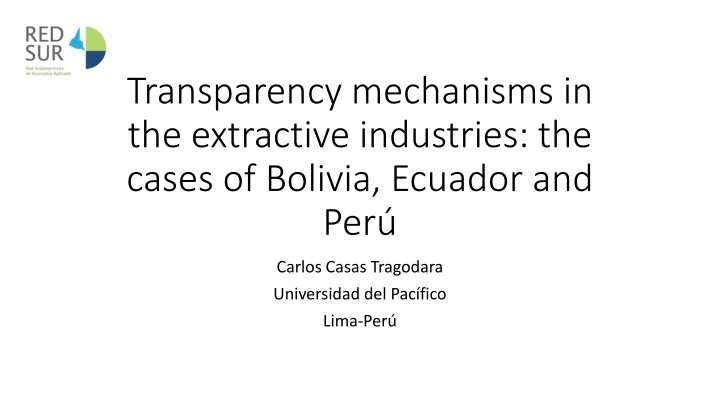
Transparency Mechanisms in Extractive Industries: Cases of Bolivia, Ecuador, and Peru
Explore transparency mechanisms in the extractive industries of Bolivia, Ecuador, and Peru, including challenges, initiatives, and civil society involvement. Learn about the impact of mineral prices on government revenues, the role of NGOs in promoting transparency, and the status of EITI adoption in the region.
Download Presentation

Please find below an Image/Link to download the presentation.
The content on the website is provided AS IS for your information and personal use only. It may not be sold, licensed, or shared on other websites without obtaining consent from the author. If you encounter any issues during the download, it is possible that the publisher has removed the file from their server.
You are allowed to download the files provided on this website for personal or commercial use, subject to the condition that they are used lawfully. All files are the property of their respective owners.
The content on the website is provided AS IS for your information and personal use only. It may not be sold, licensed, or shared on other websites without obtaining consent from the author.
E N D
Presentation Transcript
Transparency mechanisms in the extractive industries: the cases of Bolivia, Ecuador and Per Carlos Casas Tragodara Universidad del Pac fico Lima-Per
Motivation In recent years prices of minerals reach high levels and generate great profits for firms, more taxes collected by the governments and an increase in the value and volumen of mineral products. The resources generated in the last boom impacted also at subnational level because intergovernmental transfers increased. As governments had more revenues, different groups from civil society and international institutions were more interested in the use of these resources. EITI and national iniciatives has been disperse.
Transparency policies in Latin America Trasparency does not implies accountabiltiy but it s a necessary condition for it. EITI standard has been adopted by some countries in the region Results are communicated to the public in order to promote the debate about the use of revenues. There is country specific iniciatives as well. NGOs play a central role in that effort.
Bolivia There is no Transparency and public access law. Lack of articulated policy of transparency. Ministry of Institutional Transparency. Previous consultation recently implemented (under Ley de medio ambiente). In the oil sector previous consultation is included in a specific law. Limited piblic access to contracts between firms and the state
Bolivia Administrative contracts are public not because exists a law but for publicity of contracts in procurement system. EIAs are available to the public. Information about labor costs, materials, transport, royalties, taxes, insurance, etc are available but in differents sources and platforms. YPFP and Agencia Nacional de Hidrocarburos web pages include infomation but with lags. EITI: Bolivia is not part of the initiative According to the IGR Bolivia is 24 out of 58 countries in governance (but there is a weakness in access of information by the public
Bolivia Some NGOs and civil society organizations collect information and publish reports. Organizaci n Jubileo (catholic organization) elaborate different reports abou social responsability and governance around gas and oil sectors. Confederaci n de Pueblos Ind genas (previous consultation) Defensor a del Pueblo look after indigenous communities and have a indirect contact with information about extractive industries. CEDIB (independent information platform) with the goal of dissemination of information.
Ecuador There is a Law of transparency and access to public information. Previous consultation is in charge of Secretar a de Hidrocarburos. Defensor a del Pueblo (ombudsman office) process some information. Service contracts between the state and the oil firms (all public) are available but until 2012. Environmental information unique system has information about protected areas. But there is no information about EIAs
Ecuador Public oil firms report information of their prodcution and some costs but they permit only to download reports. Banco de Informaci n Petrolera del Ecuador has a lot of information about technical aspects but is only available to investors or industry members. In the mining sector exist limited information. EITI: Ecuador doesn t participate From the civil society FLACSO and grupo FARO are important players because they collect information and try to disseminate the information
Per There exist a lot of institutions regulating access to information and transparency (MINEM, PERUPETRO, MINAM, Culture and Ministry of finance) Transparency and information public access is the framework in which all the agencies provides information. Ministry of Culture has information about previous consultation (is in charge of the process) MINEM collect and publish information about EIAs and mineral production.
Per National Statistics Office publish information about production, investment, reserves of the mining sector. Taxes: The Ministry of Finance has a public access platform (SIAF) that allows to have information about the public finances in real time. Information is aggregated and there is no information by firms (collection of taxes)
Per IGR: Per 11 out of 58 EITI: Per participates and jointly with Guatemala are the two latin american countries that fulfill the EITI standard. Per has a commision with different representatives (state, firms and civil society) and has started the make reports at the subnational level. From the civil society there is two organizations: Cooperacci n and Grupo Propuesta Ciudadana who process information and make good reports and are engaged in dissemination activities.
Conclusions High rents and revenues from extractive sectors increased awareness of different stakeholders about the use of these resources. Pression for more transparency. (but not good results) EITI only in few countries Different quantity and quality of information for public access. Efforts from civil society institutions but too few dissemination of reports. It seems that there is no interest of the public.
Recommendations More information Adoption of EITI Standard Development of information platforms with easy access by the public Empowerment of civil society organizations in the introduction of IT technologies jointly with the governments More publicity of reports in order to increase awareness of the public.
